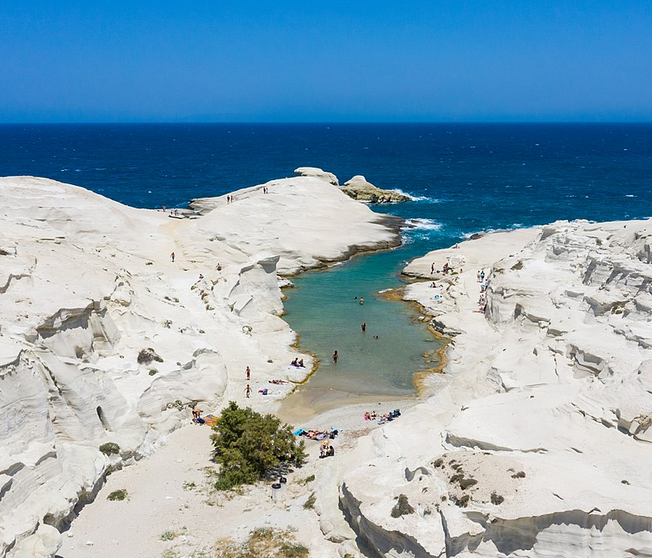For years, urban planning studies were conducted to designate a protected zone along the Milos coastline, specifying areas where construction would be prohibited and identifying landscapes of exceptional natural beauty, such as Sarakiniko. However, the island ultimately remained without special protection status.
Snapshot of the construction work for a hotel at the Kaminia site. By decision of the Ministry of Environment, its building permit is being re-evaluated.
Following the recent controversy over the construction of a five-star hotel in Milos— which sparked reactions from local authorities and parts of the community, leading to a halt in construction by the Ministry of Environment— the newspaper Kathimerini outlines the history and efforts to protect the island, which have yet to succeed.
Sarakiniko beach
Delayed Urban Planning Efforts
A contract for the Spatial and Residential Planning Study for Open Cities (SCHOAP) in Milos was signed in 2007. However, progress stalled in 2015 and was reactivated in 2021 under Mayor Manolis Mikelis. Dr. Mary Zifou, an expert in urban and spatial planning, worked on the study and described it as a "race against time" to update the research.
Key proposed changes included:
Protecting agricultural land
Establishing a landscape protection zone, including Sarakiniko
The study identified two coastal zones as landscapes of exceptional natural beauty—one on the north side (from Mandrakia to Mytakas, including Sarakiniko) and the other on the east side (from Cape Kastanas to Spathi Bay). The initial plan prohibited construction, altering the natural terrain, and road expansion in these areas. The SCHOAP also proposed classifying Sarakiniko as a protected landscape, similar to Kleftiko Beach.
Shrinking Protection Zones
Debates over the size of the protection zone and its distance from the shoreline occurred across multiple municipal councils.
Originally, a 250-meter buffer was proposed
A November 5, 2022, council decision revised this to:
150 meters from the shoreline along a 400-meter stretch around Sarakiniko
100 meters in other protected areas
350 meters in the Sarakiniko zone (up to the parking area), with 150 meters on each side
Environmental impact assessments were completed, followed by public consultation in July 2023. However, according to Dr. Zifou, the plan was not submitted on time. The Ministry of Environment later stated that all unfinished studies nationwide would be included in a new planning framework.
On Tuesday, the Ministry announced that a new special urban planning study for Milos would begin, ensuring guidelines for protecting landscapes and the natural environment, including Sarakiniko. Mayor Mikelis called for a freeze on permits until the study was approved. Dr. Zifou believes that if urban planning regulations were in place earlier, stricter limits would have been set, guiding authorities in their approvals and assessments.
Unregulated Construction Pressures
A 2023 strategic environmental impact study highlighted Milos' urbanization issues:
Unregulated construction was expanding into agricultural and geological areas
Housing pressure was disrupting Milos' traditional settlements
New developments encroached on protected archaeological zones
The Five-Star Hotel Controversy
The under-construction hotel in Kaminia became the focal point of the issue. Investors claimed their project was legally approved, with all necessary permits. The 2023 sale contract for the land plot stated that:
The land was eligible for construction
It was not irrigated and contained a stream
It did not fall under Natura 2000 or forest protection laws
However, the Ministry of Environment is now reviewing the building permit, raising questions about how such projects continue despite ongoing debates over environmental protections.









